TriggerTech is a Canadian company that started out making triggers for crossbows and Remington 700s. They’ve more recently branched into the AR-15 market (and a 1911 trigger is currently in the works). Their patented “Frictionless Release Technology” (FRT™) makes their products unique in the trigger world.
Although we included TriggerTech’s drop-in AR trigger in our AR-15 Drop-In Trigger Roundup, the product is functionally unique enough that I wanted to take a deeper dive with it and learn more about how it works. What follows is information learned from a couple of conversations with TriggerTech’s CEO and CTO.
The heart of a TriggerTech trigger — what makes it different, what makes it patented — is that stainless steel, bearing-grade roller highlighted in green in the drawing above (in real life it’s left steel-colored). Unlike basically every other trigger out there, flat engagement surfaces don’t slide against each other. It turns out this is a big deal for many reasons.
Imagine a flat sear surface and a flat hammer surface, pushing against each other to prevent the hammer from falling. The force on these two surfaces is significant, as they’re holding a lot of spring tension on the smallest possible amount of surface area. In fact, as the trigger is pulled and your finger overcomes the static friction then the kinetic friction between those surfaces, the surface area of the sear/hammer overlap gets smaller and smaller and therefore the pressure on those surfaces increases.
A lot of sear/hammer engagement surface overlap is safer, since it makes the hammer less likely to fall accidently. But that directly translates into more trigger pull distance being required to fire, which is known as trigger creep and is not desirable. To make the crispest trigger pull possible with a traditional sliding friction design, you have to limit the overlap. You have to cut it as close as you can, effectively balancing and trading off between performance and safety.
With a free-floating roller bearing between those surfaces, there is no friction to effectively move the sear in relationship to the hammer. The TriggerTech trigger starts with nearly no resistance at all — a 0-lb trigger pull — and then an appropriate trigger pull weight is engineered in. This is one reason it can be so precise and consistent shot-after-shot (as we saw in the Roundup). It’s also huge for safety.
The FRT technology doesn’t require a compromise between safety and performance. There is no need to decrease sear engagement to improve performance. No matter the desired trigger weight, the sear engagement height stays exactly the same. Low trigger pull weights are also not needed to decrease the sensation of creep or friction. The FRT allows for a creep-free design (more on this later). So even a 5-lb trigger will feel fantastic, and a half-lb trigger will have an equally safe sear engagement.
I found it very interesting that the trigger shoe itself — the part you put your finger on — is not actually the same part as the sear. It almost always is one and the same piece of metal on an AR trigger, whether drop-in or component. One reason for that is mechanical advantage.
Due to the pressure and friction on the engagement surfaces, your finger needs to be farther away from the pivot point (where the trigger rotates around the pin) than the sear in order to affect a mechanical advantage in your finger’s favor. A typical AR trigger gives you a 5:1 ratio, meaning when your finger moves five distance units, the sear moves 1. If this weren’t the case, the trigger pull weight would increase substantially. However, more advantage equates directly to more creep, as giving your finger more leverage over the sear means asking it to move farther per unit of sear movement.
Since TriggerTech’s Frictionless Release Technology is, you guessed it, effectively frictionless, no mechanical advantage is necessary. The native pull weight is zero. Instead of a 5:1 ratio, TriggerTech’s triggers have more like a 0.98:1 ratio. The sear surface actually moves more than the trigger shoe. It’s in overdrive. This eliminates creep, and explains why the TriggerTech measured as having the third least creep in the entire drop-in trigger market, despite apparently having much more engagement surface overlap.
Apparently the design and performance benefits of the roller bearing system give them a lot of design freedom within the self-contained housing. The AR trigger I tested was designed to feel like a high-end, custom 1911 trigger, but should a version be desired that has no take-up whatsoever and even less creep, they can absolutely make that. The tiny bit of creep that’s in there — so small, mind you, that my TriggerScan unit can measure it but it isn’t detectable by hand — is in there on purpose. Apparently it just feels nicer that way.
Another benefit from the roller is decreased wear. Now that the engagement surfaces aren’t sliding against each other under high pressure and friction, they last longer. TriggerTech also uses a Dvorak TriggerScan for their internal testing, and they claim to see identical, perfectly overlapping graphs of the first shot and of a scan after 50,000 shots. Under a microscope, there’s no meaningful wear on the engagement surfaces.
Reliability, too, can be improved. But not only reliability, as the quality of the trigger break is also maintained even with a lot of debris in the trigger, as the roller is very effective at kicking debris out of the way rather than trapping it or grinding it into the engagement surfaces. In part because there is no reliance on lubrication, TriggerTech’s triggers perform very well in extreme cold weather. Additionally, nearly every part but the aluminum housing is made from 440C stainless tool steel. It’s corrosion-resistant, and hardened up to HRC 55.
Most drop-in triggers are adjustable for pull weight, and most of the TriggerTech offerings are no exception. Where they do set themselves apart here, however, is that they’re click adjustable. Instead of simply tightening or loosening a freely-rotating set screw, TriggerTech’s screw has a spring detent that gives you positive click values. On their Remington 700 trigger, each click equates to a ~1 oz trigger pull weight adjustment increment (~2 oz on the AR trigger), and it’s user-adjustable from ~1.5 lbs to 4 lbs. Again, this precision in pull weight adjustment is because of the FRT — because the pull weight is engineered in rather than being a side effect of having to slide fixed friction surfaces against each other.
Finally, TriggerTech sees a commercial advantage that they’re hoping to capitalize on in the near future. One that, from the sounds of it, would benefit all of us. This is apparently the first high-performance trigger that’s suited for mass production with a high-volume manufacturing process. As the engagement surfaces don’t have to depend on extremely smooth finish quality or on flawless geometry, high precision machining (e.g. wire EDM) and/or hand polishing is no longer needed.
High-volume manufacturers could purchase or possibly license and implement TriggerTech’s technology to safely offer match-grade, high-performance triggers to their customers at a desired, high-volume-appropriate price point. Imagine base model bolt guns coming from the factory with an FRT trigger.
Overall, TriggerTech’s offerings are feature-rich and are certainly unique on the market. I enjoyed geeking out on some of the technical aspects — especially the mechanical advantage part — and look forward to seeing more from them in the future.

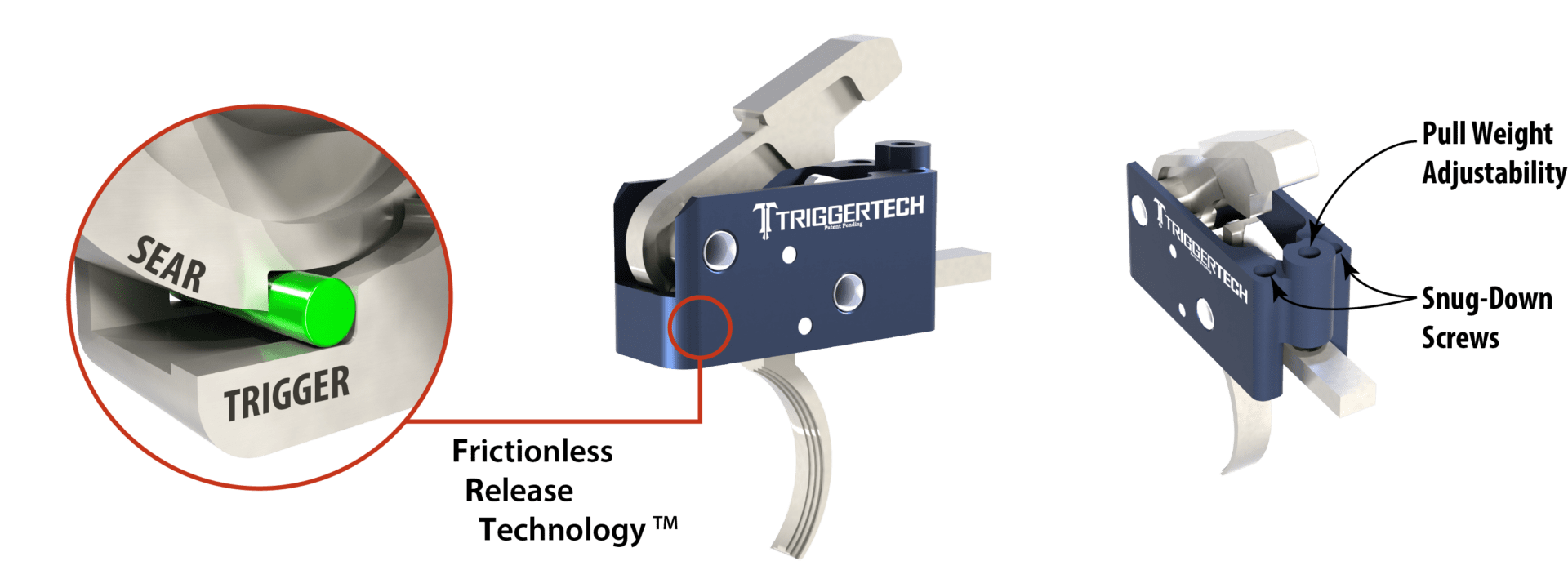
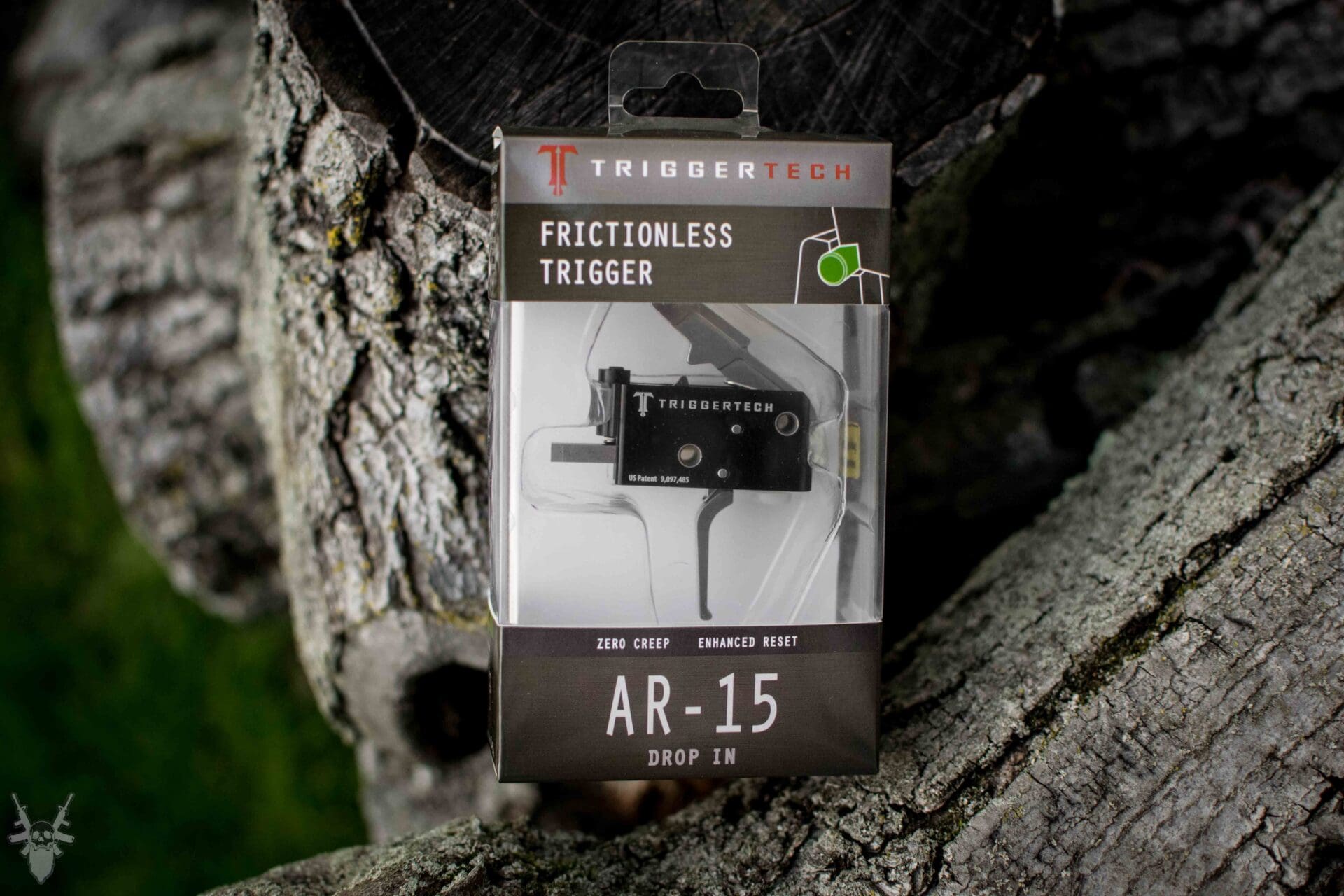
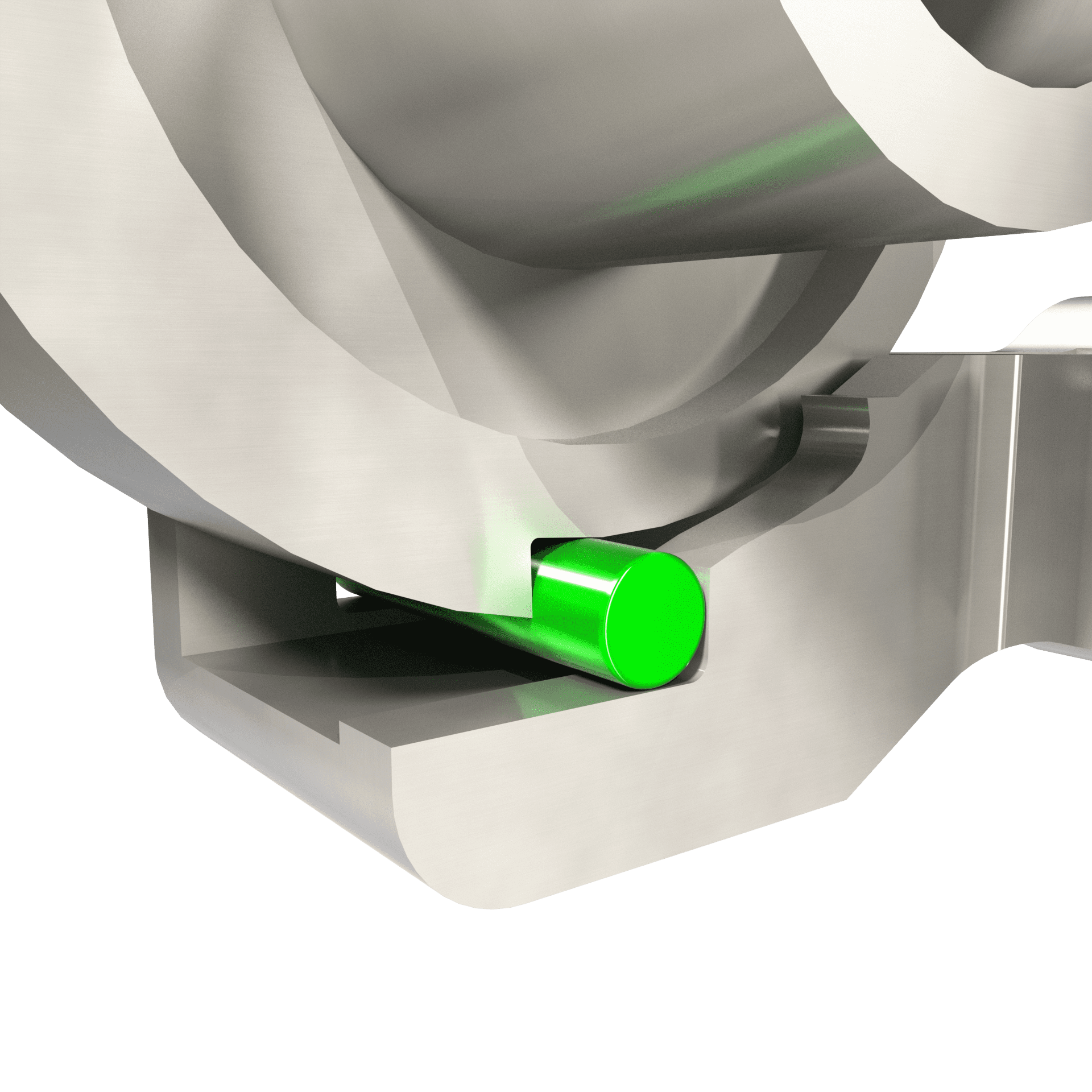
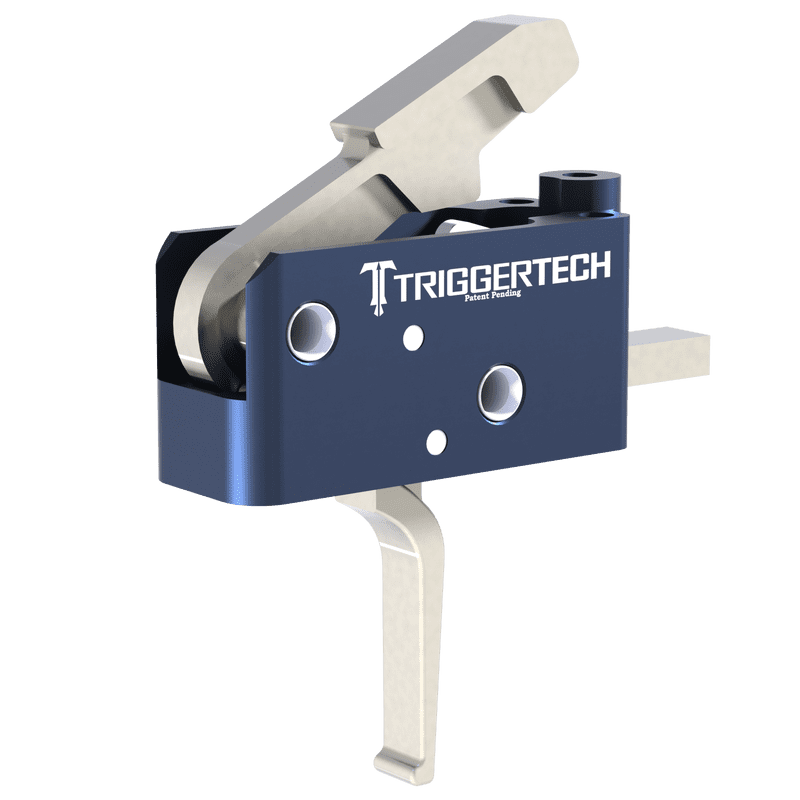
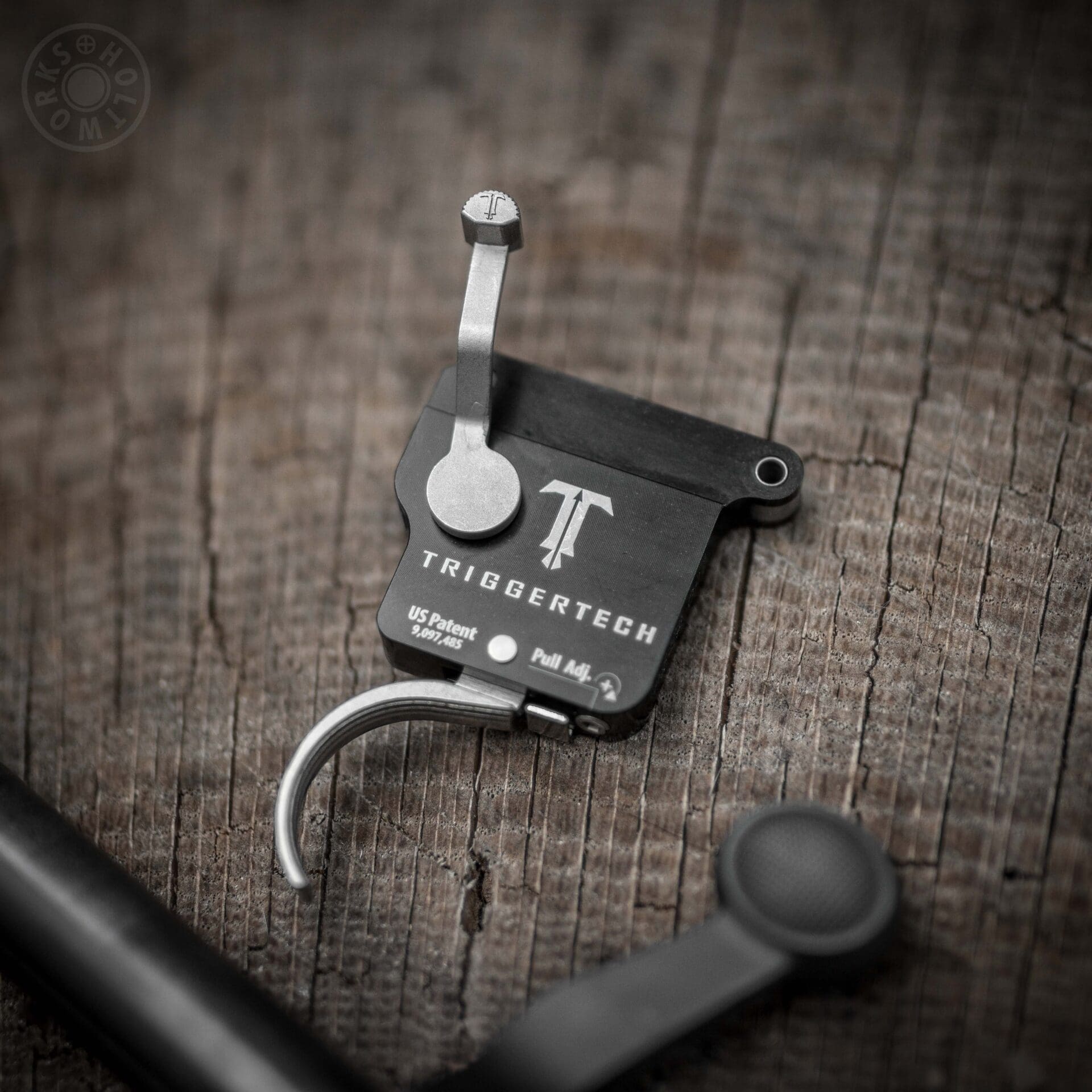
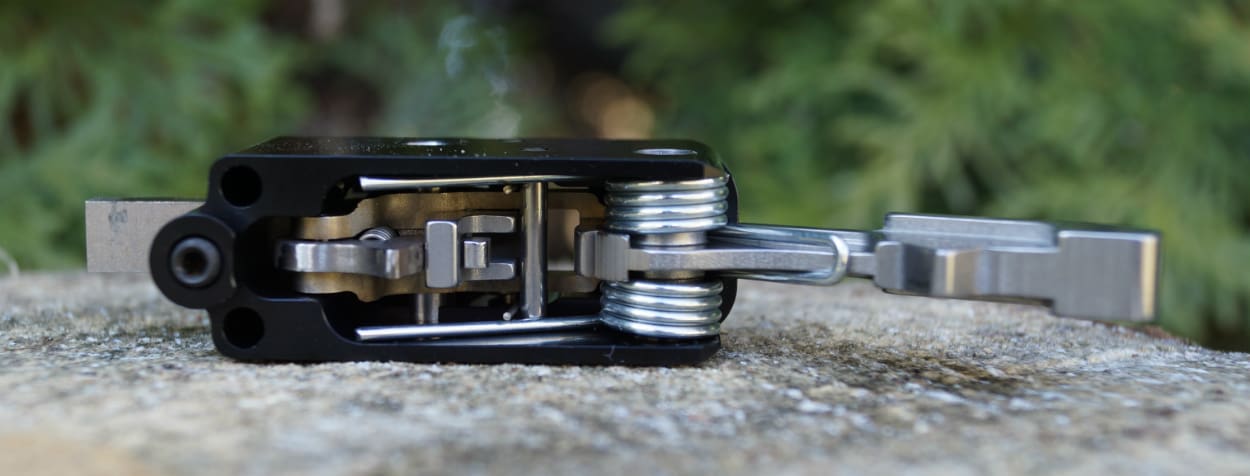
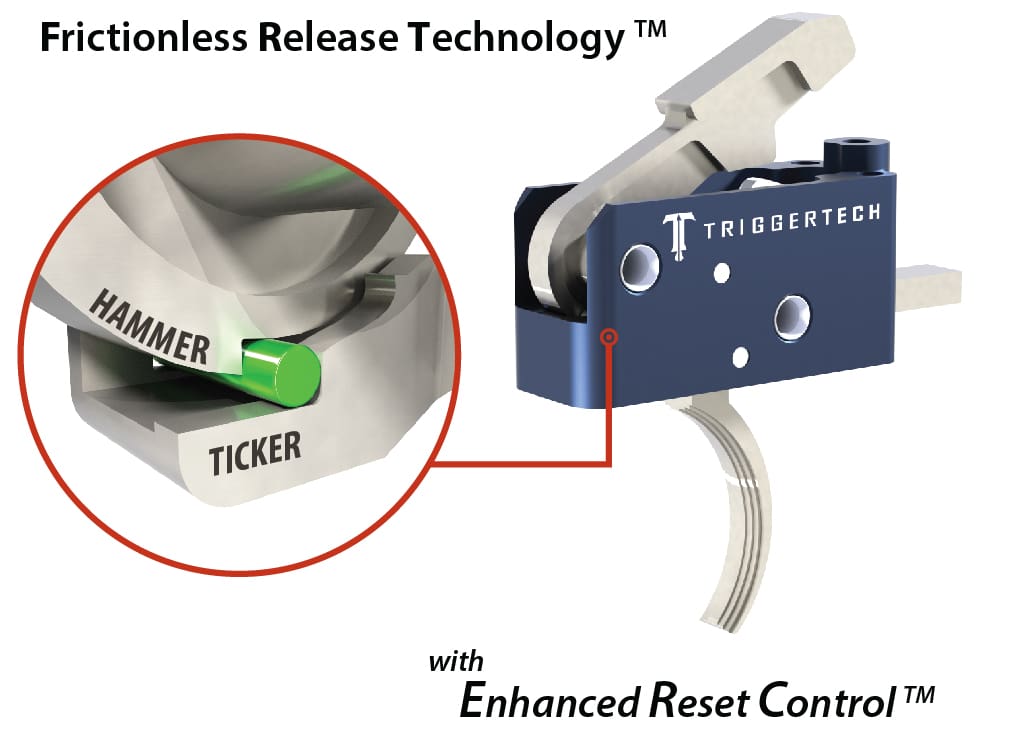
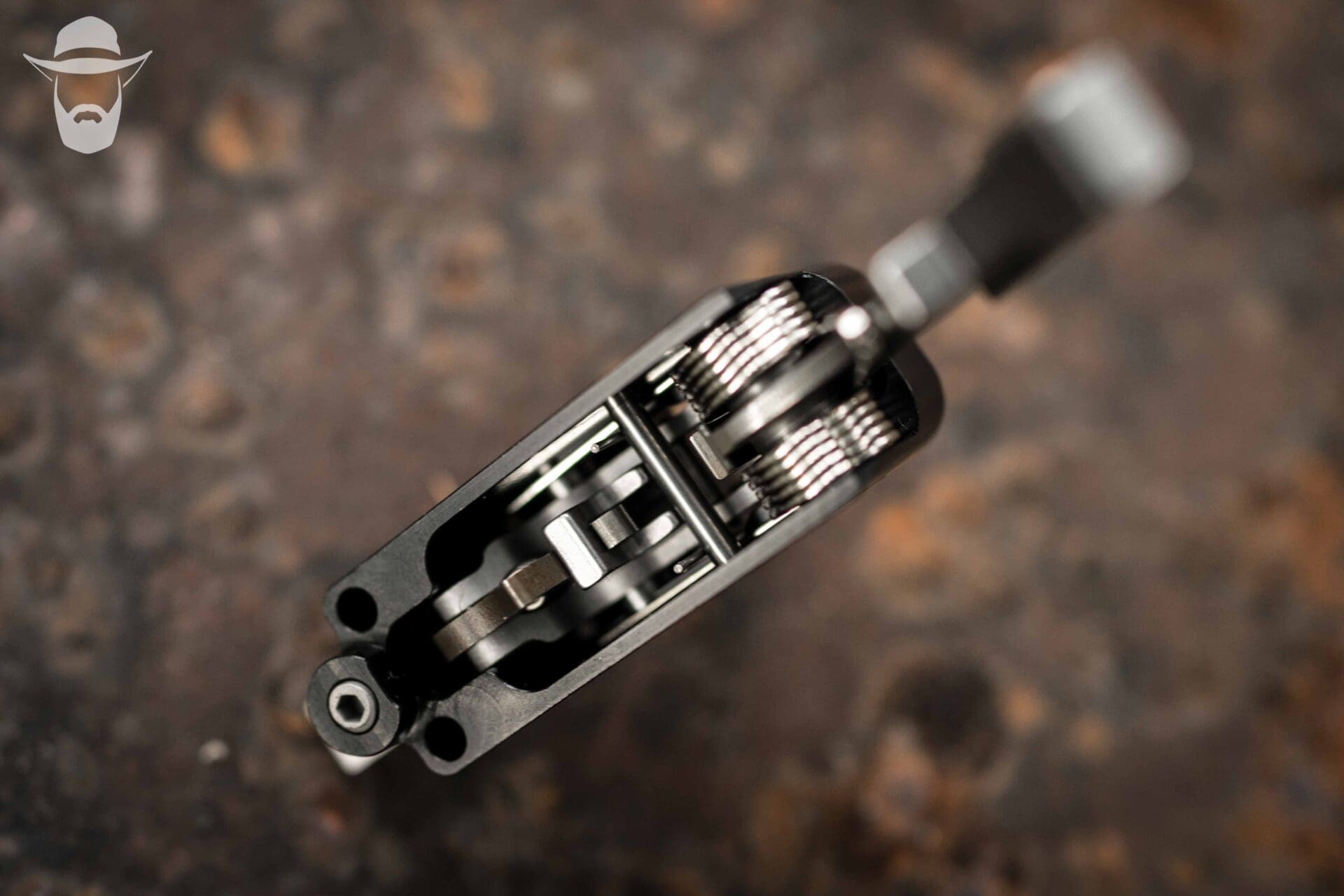
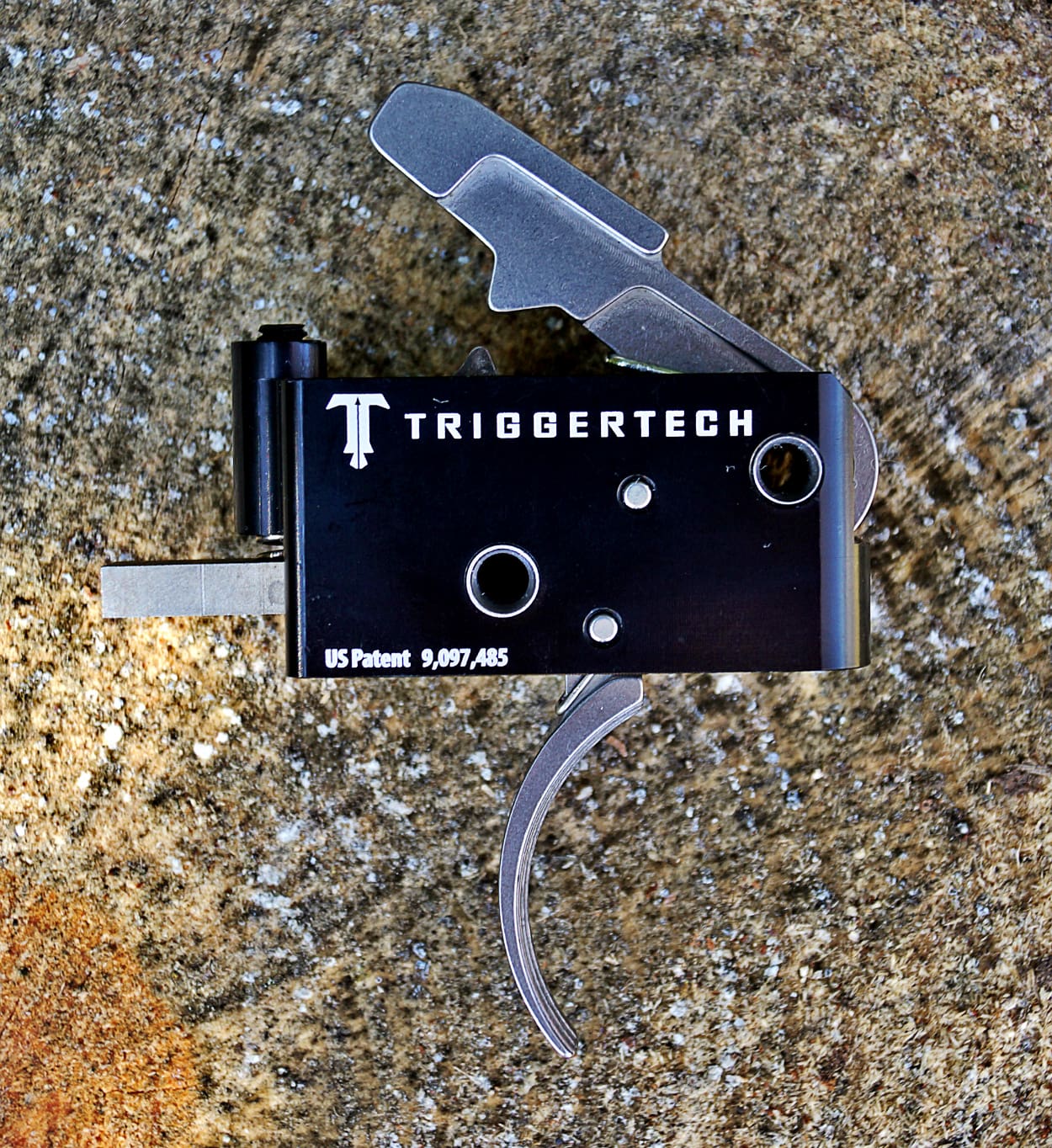
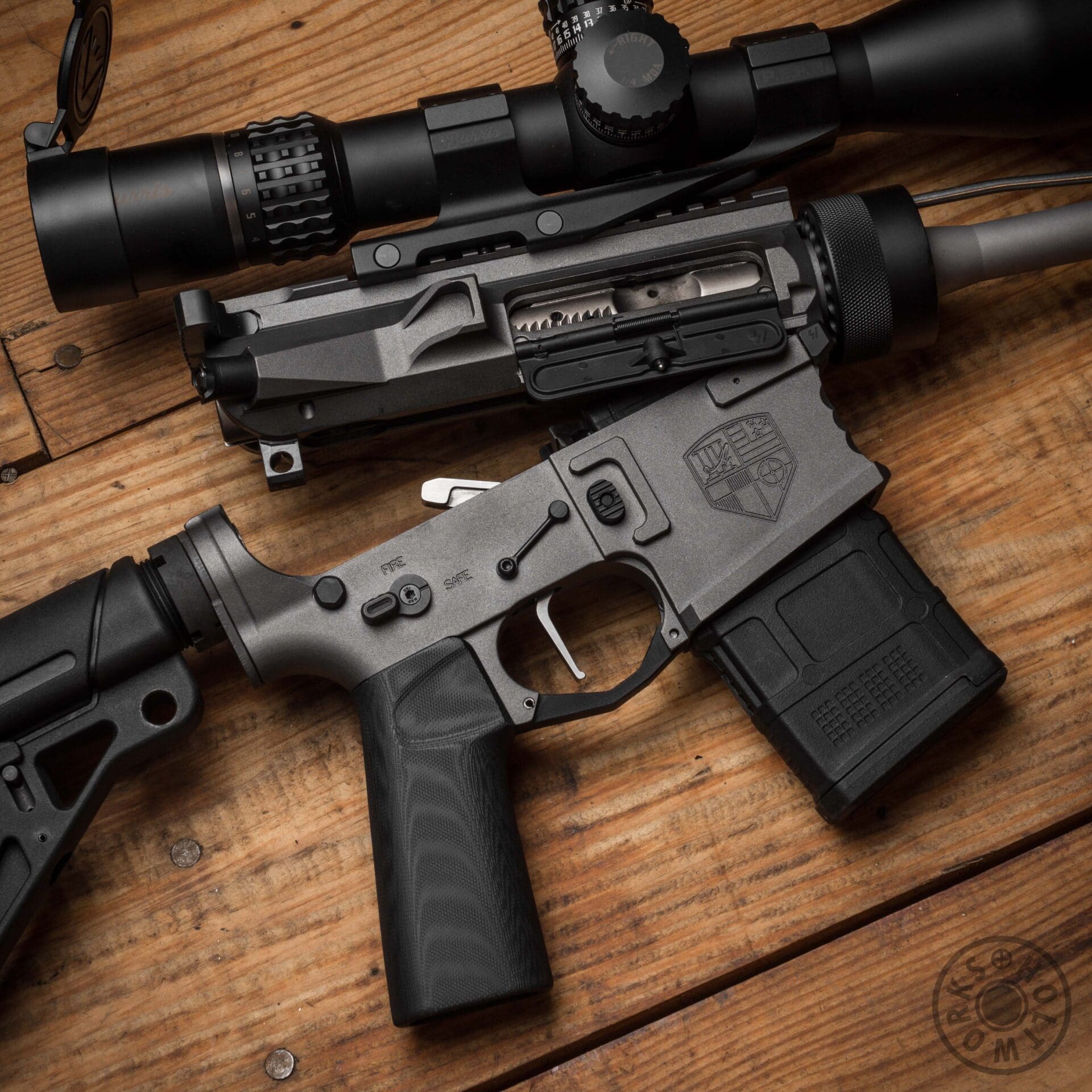

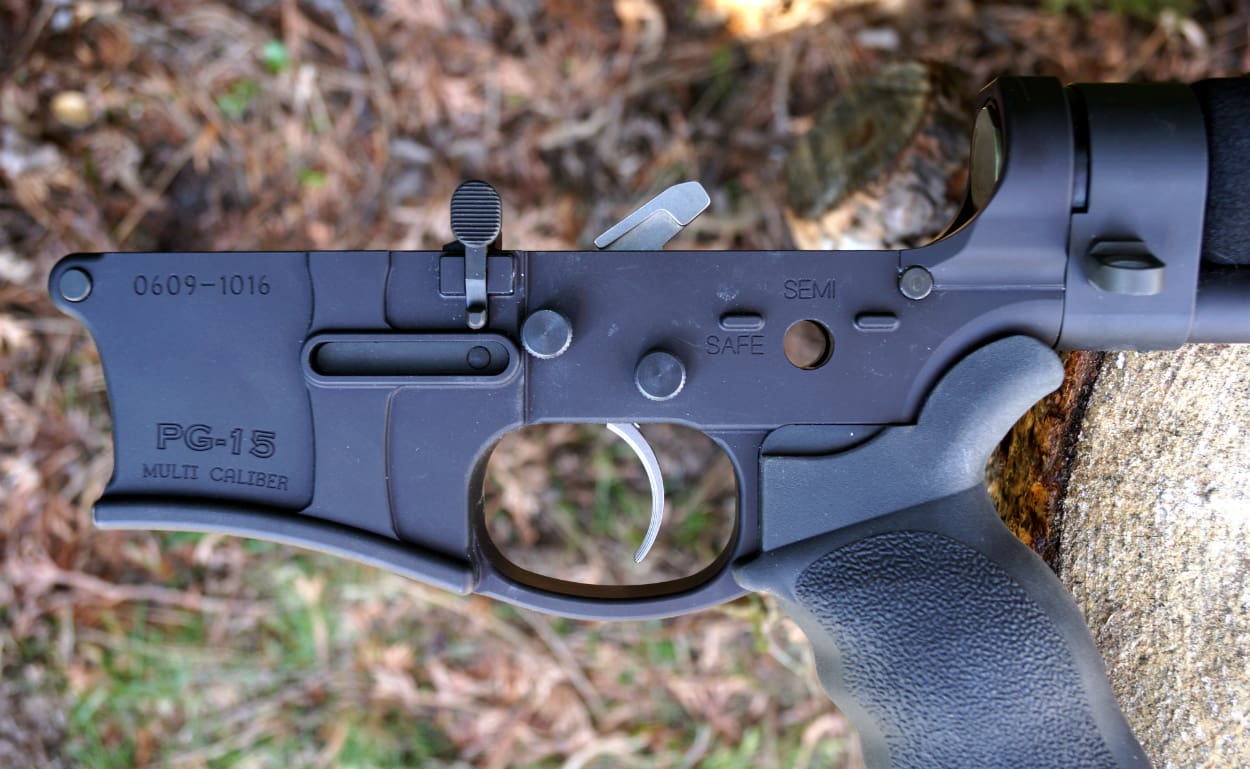



Yeah… The last thing I want in an environment where crud can get into your working components is a roller bearing. I’m wondering how it holds up to a few thousand rounds of carbon fouling.
I’m a little concerned about that, myself.
Let’s drop one of these into a .22LR caliber AR and run a couple of thousand rounds through it; that should tell us all we need to know about how well they work (or don’t work) in high-crud environments.
No offense, but roller bearings are used in thousands of industrial applications in very harsh environments and they don’t fail. I’ve got one on the 2 piece driveshaft under my F-250 diesel with 100,000 miles on it exposed to everything the road can throw at it and it’s still doing fine. I’m thinking minimal maintenance and it’ll be good to go.
If there are any auto mechanics out there who have worked on the newer vehicles , say after 2005 , with the computer gas pedal . That’s what I call them , you’ll know what I’m talking about but for those that do not know , let me do a quick background . My wife bought a brand new 2008 jeep Wrangler in 08 and it was riddled with electrical problems which resulted in many other issues , including two transmission replacements , one at 48,000 miles and another at 67,000 miles , not covered under warranty because she used the Jeep on a rural mail route . In the coarse of our four year odyssey with this piece of junk I made one discovery that blew my mind . The gas pedal had zero linkage to the carburetor or any fuel injection function other than an electrical connection which would signal a computer to accelerate or decelerate just like a computer game controller . I cannot recall what this was called but apparently there are many cars and trucks on the road like this and probably most . If you have this technology in your vehicle and you have a problem of your engine just not starting , it can be a simple computer reset . You can disconnect your battery for a couple of minutes or you can follow these procedures . (1) turn the key in the ignition to the first position wait 2 minutes , (2)turn it to the second position and wait 2 minutes , (3) de-press the gas pedal (computer controller) fully to the floor board and release it VERY SLOWLY ( literally while you count to 100 ) and when the pedal has reset to it’s dormant position ,(4)wait 2 minutes and start the engine . Are you freaking insane ? We thought so until we tried it and it actually worked . We would go from a dead , non functioning , non-starting , piece of junk , to a running , fully functioning ride . The reason I bring this up is this question . When is some gun manufacturer going to take the mechanical out of the trigger all together and leave us with a game controller in our hand that will go bang ?
It’s called an electronic throttle body and, functionally, they rarely cause problems. However, they’re still usually the bane of my driving existence as it’s very rare that the ECU throttle mapping is 1:1, linear, with the actual gas pedal position. Most manufacturers scale the throttle to make the car feel extra peppy. For instance, 2% gas pedal press gives you 6% throttle open and 10% gas pedal press gives you 25% throttle open, then it scales more or less linearly from there until the two things meet or come close (maybe 95% and above gas pedal press is actually 100% throttle). It makes the consumer go, “whoah, this car has some power!” because they barely touch the gas and it’s leaping ahead. It’s total placebo, though, a detriment to gas mileage, and really annoying to anyone who likes to drive and wants to modulate the gas pedal in a way that actually correlates to what’s going on at the throttle body. The last performance vehicle I owned, I actually used an ECU programming tool to re-map the throttle position mapping and simply made it perfectly linear with the gas pedal position until 85% pedal press where I started scaling it up so it was at 100% by like 95% press.
Guns with electronic triggers exist and actually have for a long time (Remington EtronX was commercially available in like 2004). They have never been commercial successes, though. There’s an AR-15 electronic trigger in the works that was seen at the Knob Creek Machine Gun Shoot about two years ago (I believe there’s a TTAG article about it). I think some of the Tracking Point rifles work this way — pull the trigger to the rear and nothing happens until the computer recognizes that you’re on target, then it fires the shot for you.
Let me get this straight –
You wrote all that to tell us how much these “fly by wire” systems in automobiles suck, and you wonder why no one has added this additional point of potential failure to a firearm?
Do you really want to trust your life to a system that requires batteries?
Yes Curtis , I was attempting Satire . Total failure , just like most freaking technology .
Crud builds up because it sticks to lubricants.
No lubricants = no crud. Or at least, a lot less crud.
That would be true for industrial bearings. Industrial bearings aren’t bathed in vaporized carbon every time they are used.
That depends on the industry you work in.
It’s not a roller bearing like those found in wheels and on shafts, in the sense of a part with two concentric races having multiple rolling elements between them.
It has a single cylindrical roller element which acts as a bearing surface. From the picture it appears that it contacts two sear surfaces, and there is significant gap in between due to the shape(in the pic, dunno about final product). It appears that the two surfaces work against each other through trying to impart opposite motion to the roller. When you pull the trigger, the rolling element(if it is free to rotate about its central axis) will rotate between the two sear surfaces, reducing friction. Due to the gaps between the round shape and square slot(in the picture), grit should not affect it that much, as it will naturally scrape off due to the motion, or collect in the gaps.
If this rolling element does move about its central axis(which is what i gather from this article and pictures) and it is sufficiently fouled that the roller ceases to move, it seems like you will only see an increase in friction and force required because now the sear surface might have to slide over the roller, rather than the two surfaces moving smoothly with the roller rotating in between.
All in all, seems pretty robust to me.
My concern is what happens when the carbon on the bearing surfaces starts binding with the carbon on the other components. It’s not a large surface and wouldn’t take much to start gumming up the works.
Most of us aren’t going to have thousand+ round gun fights, so it is kinda moot for us, no?
I’d have to second what Amit Jones said — should the bearing’s ability to roll get hindered, what you’re left with is basically a normal trigger where two fixed surfaces slide against each other. The “worst case” you’re thinking of here is the norm for all of the other triggers.
This same scenario also came up with the Elftmann drop-in AR trigger, actually, which uses a sealed roller bearing insert inside of the hammer and trigger pivot holes (where the receiver pins go through). People asked “well what if the bearings seize up?” and the answer is that, then, it becomes exactly like every other trigger on the market where it’s a fixed metal surface rotating against another fixed metal surface.
Try shooting a few hundred rounds of subsonic 300 BLK through a suppressed 8″ SBR and you’ll see crud and gunk like you never dreamed possible. You’ll probably need to lube the upper at least once midway through the session just to keep it running. I think the unburnt powder grains will have this trigger gunked up in no time.
You’ll never,ever shoot “a few hundred rounds” of .300 suppressed without maintenance in any kind of operational capacity though unless shit is supremely fubar anyway. If this trigger binds up the forums will know soon enough.
Physics major here, and I applaud the correct use of static vs kinetic friction, mechanical advantage, etc. Solid explanation of a cool design!
Haha- As a mechanical engineer, I liked that part too.
I stayed at a Holiday Inn Express once…
The entire product name bothered me, as an ME. Its not fricitonless. Not even close. they reduced SOME of the sliding friction. Thats not to say its not a neat design that certainly could have some big advantages. But that name… ugh.
In the sear/hammer interface, they’ve replaced sliding friction with significantly lower rolling friction. As there are other internal parts that pivot on pins, there’s still some sliding friction in the system. But there isn’t anywhere near as much force on those parts or, therefore, pressure on those pins, so it’s low compared to how much friction the sear engagement surfaces are capable of generating. Consider the pressure increase on those surfaces as the engagement overlap approaches zero but the full power of the spring is still pushing those surfaces together (surfaces that are typically very close to the pivot point, too).
The sliding friction coefficient found in almost all traditional sears will seldom be less than 0.1. Rolling friction is considerably less, around 1 or two orders of magnitude less. That said, I get you about the name, that’s the difference between marketing and engineering.
Thanking my lucky stars I’m not an engineer (I don’t even RIDE on trains!), I have to point out the claim is not no friction overall, but that it is a “frictionless RELEASE technology”. While there is friction, for example, in the basic movement of the trigger, as well as a bunch of other places, the friction of sear and hammer is gone, as the hammer and sear are not in contact.
“Imagine base model bolt guns coming from the factory with an FRT trigger.”
That would be outstanding needless to say.
Saying it another way, I would gladly pay an extra $5 to the firearm manufacturer in order to cover the patent royalties that they would have to pay to TriggerTech. And that would be a huge market advantage for the firearm manufacturer offering that firearm … even if it did cost $5 more than a competitor rifle without a TriggerTech trigger.
I believe that this system will be able to out compete the “accu-trigger” type setups so we can get rid of that funky little flipper in the middle of the trigger.
You will get the same light and adjustable trigger pull without the need for a safety flipper to prevent the hair trigger setting from blowing a hole in a customer.
This is a true evolution in trigger tech, glad they put a in-depth article about it.
Who are the distributors for this company? Their website lists Brownells, but I can’t find them anywhere else.. Brownells only carries the 700 trigger.
Just go to their website:
https://shop.triggertech.com/shop
If NAFTA ever did anything good for us, the ability to mail order gun parts from Canada might have to make the list? If that’s the case here, which I admit I’m just wildly speculating about haha
I like better. I would spend the money but (I am one of the idiot black-gun people) I still want the thing to be able to ‘go-to-war’ without any increased rate of failure over a decent-ish mil-spec trigger?
Can you comment at all on that Jeremy S.? Thank you.
No, I don’t have the personal experience with it to do so. I fired close to 200 rounds through the unit I got for the drop-in trigger roundup, but that isn’t a lot and it was under normal conditions. The manufacturer asserts that they’re reliable and that they have units with tens of thousands of rounds through them — and they continue to up the count on those — and have tested in adverse conditions, but most people read this site because they want to hear that sort of thing from an independent 3rd party. I can tell you that it definitely works fine in normal conditions and it has solid primer strikes (and is an excellent trigger in how it feels to shoot), but not much more than that.
Thank you, and thank you for your replay and the review.
This one, above all the other “trigger” replacements, really has me thinking, It’s strange how the improvements are not ‘older’ ‘features’ on other up-grade triggers, because you read your review and definitely get the face-palm “duh” effect when you read about what they put into this one.
Thank you again.
Does this change the calculation about whether a straight or curved trigger is preferable?
I’m also interested in the straight vs. curved trigger pros/cons. I honestly don’t understand the appeal of straight trigger shoes, but I have never shot one, either.
I still like the look and feel of a straight trigger shoe (also called a trigger bow). Nothing more to it other than I like how it feels on the pad of my finger better. It doesn’t change the trigger mechanically.
Gotta tell you, it all seems silly until you try it. Not to say everyone will end up with the same thing, but the first year I went to the Firearms Festival was the first time I got to actually FIRE rifles with all these different trigger configurations. Now, years later, I am getting ready to actually purchase a trigger, for a DPMS G2, and one of the characteristics I am looking for is a “L” shaped trigger, preferably skeletonized, because it feels better to me. I am still debating whether I prefer 2-stage or single-stage, although before attending the first Firearms Festival I was absolutely certain I preferred 2-stage. RF, you owe me for the plugs.
I think “L” shaped relegates you to a drop-in unit from CMC, as they’re the only manufacturer I know of who has that little hook/flange on the bottom of the trigger shoe. Not that being “stuck” therefore with CMC is a bad thing (although they didn’t stack up so hot in the roundup testing, it’s still a great trigger).
1- or 2-stage can be totally dependent on use, rather than something to prefer across the board. If I could only have one or the other I’d choose single stage, but given the option (which we do have, of course!) I generally prefer 2-stage for precision shooting — especially from a rest/bipod -, and single for most anything else. Just a personal preference thing though for sure here.
Jeremy, two of the illustrations in *this* article are of “L” shaped triggers which appear to be for an AR (one is IN an AR!). I’m talking about a straight trigger with a nub at the end to assist in placing your finger exactly the same for each shot. IOW, another option is TriggerTech!
Oh hahahaha, you’re right! I have the curved one as the straight shoe wasn’t an option when I got my TriggerTech (would have gone w/ the straight), and I didn’t even notice that nub on the bottom of their straight shoe in the pics. Nice 🙂
My current AR trigger is at 5.5 pounds. This might be the ticket to improve that.
Jeremy S., have you tried this on any of your AR’s? It would be interesting to know how they perform in the real world, as many have indicated here. Perhaps, a review is in order?
Yes, as part of writing that drop-in trigger roundup I put nearly 200 rounds through the TriggerTech unit I have. That isn’t enough to write a review yet, especially since it was all in clean conditions. Eventually I’ll have enough experience with it that I can do a review — basically, I know the trigger pull is very nice and can see that it properly dents even NATO-spec primers, but can’t yet provide any input on how reliable it is once it starts to get dirty and such.
Have Robert ship you a crate of TulAmmo and wring that baby out! I see a lot of comments worried about fouling gumming up the works. If my non-degreed mechanical instinct is correct, I would be willing to bet a brick of .22 LR that you will have to clean the bolt or de-clog the gas system at least 3 times before grime from filthy ammo makes a noticeable difference on the rotating parts that make that trigger unit work.
Yes, maybe RF or even TriggerTech will donate a case of .22 LR to the cause. I’ll happily shoot it — suppressed, no less — through a .22 LR conversion upper on an AR, with the TriggerTech trigger I already own, and document what happens. Happy to keep on truckin’ until the trigger either stops or makes it through the whole case, regardless of how many times the upper has to come out for cleaning.
Or I suppose I could just freeze it, test it, fill it with water, test it, then fill it with mud & test it like I did to my Tavor’s ShootingSight trigger 😛
Whoops! You OWN one of these? How many others do you own? Just wondering because I think this is where I’m going, too.
Larry, if you haven’t read the drop-in trigger roundup I did, I think it would be worth your time. It’s linked in the article above and EVERY drop-in trigger on the market (other than white-labeled versions) is compared. I didn’t keep all of them, but I kept a few of the ones I like the best, and the TriggerTech stayed.
Yeah, just read the original yesterday, somehow missed it before but this article led me back to it. Thanks for both!
I hope soon. Looking forward to your review.
This method isn’t actually new. The Korth revolvers use a similar system with the rolling “pressure wheels”.
That said, it is good to see such a mechanism finding its way into the AR-15 and 1911 market, as it will likely see greater acceptance elsewhere to the benefit of most shooters.
The remarks about the ease of manufacturability are on point, the “accuracy” is built in via the roller and slot it sits in, which means you only need at most 3 “precision” surfaces, two of which can be made in one operation, leaving the roller itself, which is trivial.
If they made a straight shoe for the Rem700, I would try it.
TriggerTech chart aside (and I had to click through to the original drop in trigger comparison novel- I mean, post), this whole write-up really feels like an ad. Sorry, but it really does.
As mentioned at the top, it’s information straight from TriggerTech’s CEO and CTO. This isn’t a review or an independent analysis, it’s mostly TriggerTech’s description of what makes their trigger unique. I had hoped that was clear.
For a non-ad, read the original drop-in article, which is linked.
I seem to be a trigger sucker, with 3 AR type platforms I appear to be shopping for my fourth aftermarket trigger. OTOH, when I bought my first around 2002, I thought I’d been suckered, couldn’t possibly make any difference, until I took it to the range and my group size had been cut in half.
Just may have to get one for the 700 I am rebuilding.
I see that the unit for Rem 700 has a safety built-in, but none on the units for AR-15. Does the TriggerTech unit work with the existing AR-15 safety lever?
Yes, any to-spec AR-15 safety would work with this trigger (or any of the other drop-in triggers on the market).
Great! Thank-you!
Looks cool? However, I’m sure they want hundreds and hundreds of dollars for it. Lots of folks will fall for it, if just for bragging rights at the range.
$129 for Rem700, $169 or $199 for AR-15 depending on if it’s fixed pull weight or adjustable pull weight. If you browse through the drop-in trigger roundup I did, you’ll see that these prices are actually a bit below average (~$212.85 is the approximate average cost for a drop-in AR-15 trigger).
You’re right that $199 is less than $212…but the implication of the following statement is that it should still be quite a bit cheaper than it is, right?
“This is apparently the first high-performance trigger that’s suited for mass production with a high-volume manufacturing process.”
Well and $169 (price of TT’s non-adjustable AR triggers) is significantly less than $212, and I’d argue that’s an even more apt comparison since the majority of the other triggers in question aren’t actually end-user adjustable for pull weight. If we compared TT’s $199 adjustable one to the others that are adjustable, we’d probably see a similarly large price gap as it would remove nearly all of the ones that are priced under TT.
But regarding the manufacturing question, TriggerTech isn’t a mass-production, high-volume manufacturer. They’ve created a trigger that is capable of being manufactured properly at a huge scale, but if that were to happen I think the licensing of TT’s design to a large company would be the more likely scenario. As a small, relatively new-to-the-market company I personally doubt (no actual info to know for sure) that they’re manufacturing at large volume in a “mass-manufactured” process currently.
I dearly love my shiny new DPMS G2, but the trigger leaves me cold. I don’t have anyone but my sons to “brag” to, but I think I would like this trigger more than what I have. Perhaps you are engaged in a competition for “bragging rights” about how cheap you can be or how much you can cheat someone, I am searching for what *I* want, and I am willing to pay for it. Cheaper and cheaper crap is not what I seek. You have fun, now.
$200 is low for a drop-in but I still prefer ALG Defense ACT triggers. I can pick up used ALG’s for $50-60 and they function just as well as many of the drop-in kits that I’ve tried. If these triggers ever hit $100-120 I might pick one up.
I can sure appreciate that, the most advantage I can see from the fact a set is “drop-in” is only from the few minutes of installation, tho Jeremy explained well how slightly different hole positions could alter the result. But first you have to be familiar with the installation! I now have several sets of non “drop-in” triggers sitting around in sandwich bags, no idea what they are or how to reinstall them. I guess ya pays your money and takes your choice. If I decided to install one of these, and later wanted to try another, I could swap them out in 5 minutes, and swap back equally simply if that didn’t result as desired. And be able to distinguish one from the other.
Seems like the break would be profoundly bad, though. Like mushier than a cheap stock AR trigger is gritty. I’d like to see a review of this by someone who has a lot of experience with good triggers, meaning comparable triggers like Geissele.
It’s not bad or mushy. As mentioned in this article, it has the third least creep of any drop-in trigger on the market. Please refer to my AR-15 Drop-In Trigger Roundup for more info. It has objective data from the Dvorak TriggerScan that not only provides hard data on different aspects of the trigger pull but allows you to kind of visualize what it feels like, especially as a comparison to the trigger pull graphs for the other triggers. At bottom in that article (the “Other Comparisons” section), you’ll see a graph of the Geissele SD-3G, too.
Maybe a dumb question, but they have to be single stage then, right?
May be possible to put a small bump at the end to make it 2 stage but that part woulden’t be adjustable then.
They could do 2-stage. In fact, the current AR trigger basically is a 2-stage trigger as it’s designed to mimic a very nice 1911 trigger. There’s some take-up travel — 0.025″, to be exact — at a 0.7 lbs pull weight, which is effectively a short first stage, before you hit the second stage where the trigger shoe stops and requires between 2 and 5 lbs (depending on where you set it, if you have the adjustable model) before it breaks. They told me that they can engineer this out, but I don’t see any reason why they couldn’t also engineer a longer first stage in if they wanted to. The second stage is always the trigger break, by the way, and the first stage is a differing amount (distance) of pre-travel at a lower weight than what’s require to break the trigger. The ratio of 1st stage weight to 2nd stage weight is mostly a matter of personal opinion, but is nonetheless a topic of some debate haha
Intresting. So is the 1st stage super short compared to the second stage then? Usually its a long first stage and once you can feel the second stage it’s on the brink of breaking
The usual case as you described it is exactly the case here. The second stage is the break. If it’s moving during that then you’re experiencing trigger creep. This trigger has extremely little creep and a very crisp break. It’s just the case that the “first stage” here is extremely short. The “second stage,” however, really has no travel at all that you can detect with your finger prior to the trigger breaking.
You know, I probably should have made a video like this for every single trigger in the Drop-In Trigger Roundup (but with a camera on a tripod rather than with my cell phone in one hand and the trigger in the other haha), but I think it’ll help a lot in this case: https://youtu.be/6Ren1E9HS5M
Trump should build a wall on the NORTHERN border and keep out the gun grabbing Trudeau socialists from Canaduh.
I installed one of these in a Remington 700 AAC-SD. Of course it makes the original trigger feel bad. That’s the purpose of an aftermarket trigger.
Set it to its lightest setting and tried the bump test. Way too light. Adjusted it up a little and it was good to go for safety.Not sure of the actual pull weight as I don’t have the tester. But it is light. When you put your finger on the trigger there doesn’t feel like there is any take-up. Just pressure until it goes bang. After a while you get a sense for how much pressure sets it off and it’s easy to control.
Have about 400 rounds shot with it and zero issues so far. Have not shot a Timmy or Jewel trigger to compare but I like it. It feels like a really solid trigger.
Comments are closed.